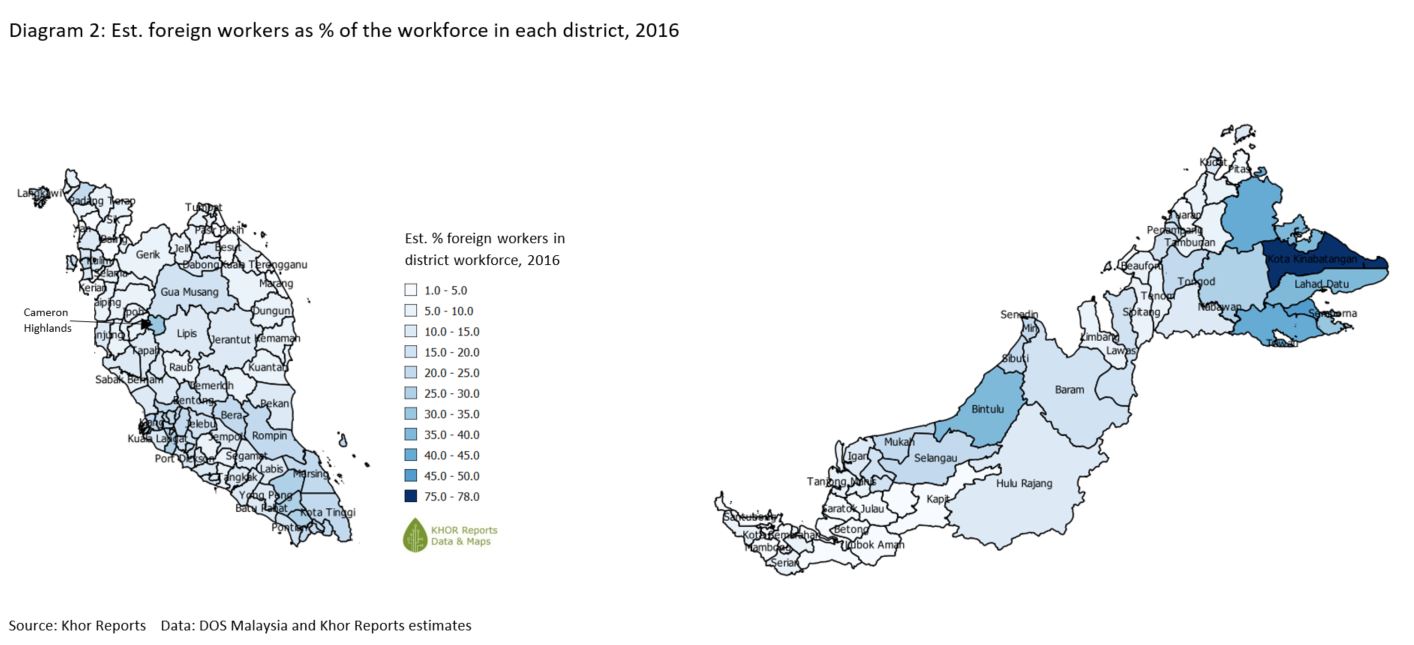Foreign Workers in Malaysia: Case Study of Oil Palm in Johor and Sabah
By KHOR Yu-Leng
The spatial distribution of foreign workers in Malaysia is a topic that has not been well studied. At Khor Reports, we try to fill the knowledge gap with a preliminary review of the district-level data for the entire country. We analysed the foreign worker ratio in each district and focused on two case studies: the oil palm zones in Johor and Sabah to identify new insights.
The spatial distribution of foreign workers in Malaysia can be examined by mapping DOS non-citizens data by district. See Diagram 1.
Diagram 1: Distribution of Foreign Workers in Malaysia. Source: Khor Reports
By making reasonable assumptions about age distribution, labour force participation and noting the different immigration policy of Peninsular Malaysia and Sarawak versus Sabah (which allows families of migrant workers to reside), we may derive estimate of foreign workers as a percentage of each district’s workforce. See Diagram 2.
While we expect some under reporting of the data (likely due to coverage issues), this data set still proves to be relevant. Known areas with large ratios of foreign workers are prominent throughout the country. These include Cameron Highlands (an important hill farming district) and districts in the center of the Peninsular (farther from the coast) and in the south-east oil palm and agriculture zone. In East Malaysia, Bintulu and its neighbouring districts in Sarawak and Sabah’s eastern region surrounding Sandakan are major plantation zones. Based on our geo-economic analysis of the official district-level data, these regions appear as more dependent on foreign workers.
Diagram 2: Share of Foreign Workers in Malaysian Workforce, by District. Source: Khor Reports
Table 1 shows the Top 15 districts by the official count of non-citizens for 2016. This shows the large populations of non-citizens in the urban-industrial centers (without dependents in the Peninsula) and also in the plantation zones of Sabah (with dependents) in East Malaysia.
Case Study: Oil Palm in Johor and Sabah
The oil palm plantation industry is a major employer of foreign workers (estimates of foreign worker reliance typically range from 70 to 90%). Given its prominence, we examine major oil palm zones in Johor and Sabah to understand the probable distribution of non-citizens in oil palm and other agriculture work (based on typical land labour ratios) and other roles (non-agriculture and dependents in the case of Sabah). However, we are unable to account for the possible under-counting of foreign labour numbers that would arise due to opportunities for other agriculture and non-agriculture jobs in these states.
For Johor, the districts of Batu Pahat, Kluang, Kota Tinggi, Mersing and Segamat account for about 75% of the state's oil palm areas (see Table 2). Oil palm may employ about 40% of the almost 110,000 non-citizens in those areas. There appears to be potential for a large number of other agriculture jobs too and other (non-agriculture) work could employ 11% of the non-citizens. The highest ratio of oil palm workers are probably in Kota Tinggi, Mersing and Segamat; likely employing over 60% (estimate) of non-citizens.
Diagram 3: Share of Foreign Labour in Major Oil Palm Production Zones. Source: Khor Reports
For Sabah, the Top 10 districts analysed have about 1.4 million hectares of oil palm areas (90% of the state's total oil palm planted area) and 0.8 million non-citizens (see Table 2). As Sabah allows for dependents to accompany workers, it is not surprising to find that the ratio of dependents could account for up to 80% of the non-citizens count, assuming that citizens take up all the non-agriculture jobs. We estimate that the potential agriculture jobs would represent 20% of the non-citizen count (the majority is oil palm, at about 16%). We derive the ratio of dependents from the number not easily accounted for as oil palm and other agricultural workers (via typical land-labour ratios).
Diagram 3 depicts the case study states and the districts with larger oil palm areas are highlighted in blue. Dark blue features the districts where non-citizens may be more heavily reliant on oil palm jobs. Because Sabah allows dependents to be resident, their numbers greatly dilute the "reliance on" ratio for the big oil palm districts of Kinabatangan, Lahad Datu, Sandakan and Tawau. Reliance on oil palm by non-citizens appears to be high in Beaufort, Beluran and Tongod. Presumably this may also come to be diluted by the immigration of dependents and other workers, as the local economy evolves.
(c) 2018 Segi Enam Advisors Pte Ltd. All rights reserved.
With geospatial data research by Jeamme Chia.
KHOR Yu-Leng is an international economic consultant on Southeast Asia and sustainable commodity supply-chains. She is the Head of Research at Khor Reports - Segi Enam Advisors Pte Ltd. Her socio-economic and geospatial economic analyses also features in the international media, think tank and academic publications.
#Labour #MigrantWorkers #PalmOil #Sustainability #RSPO #Johor #Sabah #Malaysia #SoutheastAsia #KhorReports
We've released a new data report on our analysis of Malaysia's structural reliance on foreign labour. To access the full data report, sign up for our newsletter to receive your exclusive password to the report! The report is accessible at this link: Malaysia's Structural Reliance on Foreign Labour (Khor Reports)
A sample from the data report







